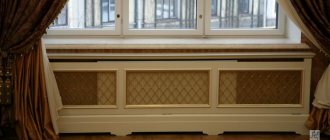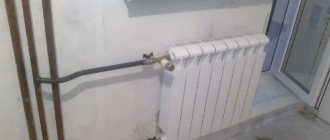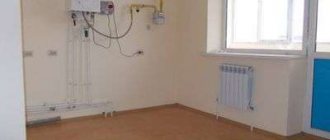/Accessories and decor/Decoration/
When an unsightly heating radiator spoils the interior, there are several ways to solve the problem: replace it with a designer or in-floor model, or simply cover it with a screen/box. The latter method provides several advantages:
- A screen or box not only hides a bulky structure, but often decorates the room.
- The screen/box can be used to build an additional console, a shelf for decoration, a bench, a rack, or a desktop.
- A closed battery is safer for children - there is no risk of burns or accidental impacts. However, one can argue with this argument, because it is in the children's room that heat loss is least needed.
In a children's room, the radiator should be covered with a nice grille with a large number of holes, for example, carved like in this photo
- If the house is too hot and dry, then closing the radiator will help create a comfortable microclimate for household members, their pets and plants.
- The screen prevents dust from settling in the inside of the radiator and thus simplifies cleaning.
There are also disadvantages:
- The heat transfer of a closed battery decreases on average by 10-15% or more (depending on the degree of closure);
- Screens and boxes often make it difficult to service radiators, and sometimes even block access to them.
- Often, improperly closed batteries lead to fogging of windows, and then to the appearance of harmful mold on slopes and walls.
- The screen or box, at least a little, “eats up” the space around the radiator. After all, any elements should be installed at a distance of 5-10 cm from the battery.
- Battery fencing requires additional expense and hassle.
Later in the article we will tell you how to close radiators without compromising the heat in the house and show with an example of 70 photos how to do this beautifully.
What to consider when masking a battery
Before you start masking, you need to know a few important nuances:
- The first thing you need to understand is that with any method there will be heat loss.
- Convection air flows should not be blocked by anything; this is the only way to maintain uniform heating of the room, and the windows will not fog up.
- For various emergencies, it is worth considering in advance free access to threaded connections and the radiator - this could be a window or a removable structure, for example, a door with hinges.
- For repairs, the faucet, thermal head and other elements of the heating system must remain in good accessibility.
Kitchen along the window [15 ergonomic options for the home]
Interior in modern style
A work area located along the window can rarely be found, for which there are several reasons such as the battery and the lack of necessary access to the window. However, in some situations, such a design is the only opportunity to obtain the most optimal solution for organizing space. In what cases is the placement of a kitchen unit along the window justified and does such a kitchen layout have its own characteristics?
Large windows will fill the kitchen with natural light
The best ways to beautifully hide radiators
There are several ways to hide batteries; in this section we will look at the most popular and effective ones.
Hinged screen
It is by far the most practical and popular method; most often this design is made of metal and has its advantages:
- simple installation;
- heat exchange remains the same;
- can be made with rounded corners, which reduces the risk of injury.
Glass screens
A screen made of glass will be an interesting and stylish solution, especially for those who choose minimalism or a modern style in interior design. Photo printing or various patterns can be applied to the glass, but this method is not a budget option. Installation is carried out on a screw holder, but you will have to drill holes in the wall. However, the heating radiator will be stylishly protected. This option will fit into any interior.
Box screens
Box screens are an excellent option for decorating radiators.
- They will help to completely hide the battery.
- The box can become a piece of furniture.
- Erans are easy to install and easy to care for.
- Protect from burns or other injuries.
The photo shows an original green wooden box in the children's interior.
Curtains to the floor
Let’s not forget about the most popular way to hide batteries - simply hang them with opaque or translucent curtains. Using this method, over time you will even forget that there are pipes and a radiator behind the curtains. The main thing is to choose curtains that will look harmonious and not show everyone that there is something behind them.
Painting the walls in color
How to hide a heating radiator on the wall if other designs are “prohibited”. There is only one way to paint it the same color as the wall.
Wood frame
Wood will create coziness and warmth in the apartment, and the disguise of the battery will be elegant and beautiful. This option is for those who are furnishing their home in eco-style using natural materials. These ways to hide batteries can be used as a stand for home decor.
In the photo, ordinary wooden blocks stylishly hide the radiator in the kitchen.
Built in furniture
Another common way to cover a radiator is custom-made furniture or built-in furniture (shelves, cabinets, folding tables, seating).
Hide the radiator with furniture
Arrange furniture, such as an armchair or desk, so that it covers the radiator. A cast iron radiator is not attractive to many, but pieces of furniture can hide it.
Replace with designer model
For those who don’t want to invent anything, unique designer ways to hide batteries have been developed that already initially have a beautiful appearance and you simply don’t want to hide them.
Original ideas
There are many creative ideas that can turn batteries into a decorative element:
- Forged products
- Hide the radiator with fabric
- Painting and decoupage of batteries
In the photo, with the help of a beautiful painting, the battery has merged with the wall.
Hanging screens
A battery screen is the most affordable way to hide a radiator, although it is far from the most aesthetically pleasing. There is no need to install them specially; they can be installed simply by hanging them on the heating device. True, by closing the radiator itself, they do not solve the problem with the supply pipes. The hinged panel, allowing you to hide the radiator itself, very slightly reduces the level of convection and heat transfer, plus - they are mostly metal (although if you catch them, they do not ring very pleasantly).
Hanging screens are cheap and easy to install
Hide with drywall
Separately, I would like to talk about how you can hide batteries using drywall. It’s worth noting right away that the material has its drawbacks, but plasterboard construction is still very popular for repairs.
- The material is environmentally friendly and is not subject to combustion.
- You can find several varieties of this material on the market.
- This camouflage option is budget-friendly, and installation can be carried out in different ways, in a way that is convenient for you.
- Also, it is drywall that will allow the apartment owner to come up with any design, which will help not only to cover the pipes and radiator, but also to make additional decorative elements.
The downside is that drywall is afraid of external influences; if you do it carelessly, it is quite easy to break or pierce it. And if a breakdown or leak occurs, the entire finish will have to be replaced again, but this material is cheap.
Plastic gratings
Cheap, but at the same time definitely not for residential premises, they will hide the battery/pipe, but when heated they can release compounds dangerous to humans, especially if the panel (grid) is made of cheap plastic by a “gray” manufacturer.
Plastic grilles to hide the battery
Advice! Plastic screens are suitable for non-residential premises, taking into account their resistance to high humidity - for bathrooms.
Do-it-yourself installation of a plasterboard box
In order to close the battery, you need to measure it, and then buy metal profiles and other additional products.
- What materials are needed: 12 mm plasterboard sheet, metal profiles 27x28 and 60x27, self-tapping screws for plasterboard and metal, dowel-nails 6x40 in size, construction sickle, perforated corners.
- Tools: screwdriver, hammer drill, metal scissors, stationery knife, stapler, pencil, tape measure, building level.
Attention, for the construction of a plasterboard box there is an important requirement: the window sill must extend beyond the radiator by at least 3 centimeters.
Work order:
- Installation of the frame. The profile should be mounted on three adjacent sides: floor, wall, window sill. Press the 27x28 metal profile to the base with your hand, drill a hole using a hammer drill in both the profile and the wall. Using a screwdriver, screw the dowel-nail into the hole. At the bottom of the window sill, a 27x28 metal profile is mounted on self-tapping screws; the length of the screws should not be greater than the thickness of the window sill. Next, you can install jumpers made of metal profile 60x27.
- Selecting the grid size. This hole must be made slightly smaller than the grid size. You can focus on three recommended sizes: 60x120, 60x90 or 60x60.
- Installation of drywall. Plasterboard sheets can be cut with a utility knife. Screw it in with a screwdriver.
- Installation of corners. They must be secured at the corners with a construction stapler, or attached to gypsum plaster. Serpyanka should be applied to all seams of the plasterboard box and covered with plaster. Before painting or wallpapering, the plasterboard box must be puttied, sanded and coated with primer.
Layout advantages
Owners of a small area of 6-9 sq. Every centimeter of space is important, in such a situation it is simply not possible to leave a corner unused. And for owners of a narrow kitchen, placing a set along the wall means making it even narrower. In this case, the location of the working area along the window will help balance the elongated size. In addition to the forced necessity, this design has some advantages:
- Functionality.
In a small room, using space along the window makes it possible to increase the area of the headset without cluttering the space. - Stylish.
Abroad, the kitchen layout under the window is very popular. This design meets all modern trends and looks super stylish. - The window
can also be used by increasing the tabletop at the expense of the window sill and thus expanding the work area. - Lighting.
By working next to a window during the day, you get natural light in the kitchen and at the same time a beautiful view from the window. Isn't it nicer to look at trees than at a blank wall? - Originality.
How often can you come across such a layout? Using a window will make the interior more modern and unusual.
Using window space will make the kitchen seem larger
Spectacular idea with mirror inserts
Advice!
Do not place the hob . In this case, it will be difficult to install a hood There are more interesting ideas for using the window.
Masking heating pipes
It doesn’t matter whether it’s an apartment or a house, a bedroom or a kitchen, everywhere I would like to have a good renovation. Questions immediately arise: how to beautifully hide heating pipes and how can this be done with minimal cost and maximum efficiency? At the same time, the method of disguise should be truly invisible and unnoticeable, fitting into the room.
The pipe can be hidden inside the wall, or it can also be closed into the floor. Remember that the old heating system should not be hidden in this way; this option is possible after a complete update of all elements.
Box on frame
It is best made from wood, plastic or plasterboard. Do not place the heating pipes close together; there should be at least three centimeters between the box and the pipe.
Hide behind decor
Decoration of pipes in various ways, for example, wrapping them with jute rope. But remember that this reduces heat transfer. Many owners decorate pipes with flowers; this can be done using bamboo with leaves. Only imagination should work here; even an old pipe can look completely different.
Painting to match the color of the walls
The easiest and most practical method is to paint the radiators or riser in the same color as the walls, but the heat generation will not be reduced.
In the photo in the kitchen interior, the pipes are painted to match the blue walls.
Hide under the floor plinth
A good invention was the floor plinth, in which you can easily hide batteries located horizontally and low to the floor.
Technical rules
One of the requirements is the accessibility of the radiator. It may leak and will have to be replaced or repaired. Therefore, it is better to choose designs that are easily removable. It is advisable that they do not have a fixed mount. Overlays with a folding door and a retractable mechanism are suitable. At a minimum, valves, pipe connections, thermal head and threaded connections should remain accessible in case of breakdown.
Instagram @interior_techno
Instagram @bespokecabinets
The second important point is related to the amount of heat entering the house. Any box reduces it. Especially if it is deaf, completely closed at the top or has a tight weave. It is better to choose something more open and not place the heater too deep. To reduce heat loss, you can put a solid screen on the legs and cut a groove in the middle.
Another way to compensate for heat loss is to install a heat-reflecting screen behind the battery. For example, polyethylene foam.
A few more tips
- Before closing the radiator, prepare it: wash it, blow it out.
- The distance between the masking structure and the heating device should be 35-50 mm.
- The minimum gap between it and the window sill, as well as the floor, is 60-70 mm.
Consider these recommendations when choosing a decorative overlay. After installing it, the temperature in the room should not drop by more than 1-1.5°C.
- Heating
How to choose a heating radiator: 4 important criteria
Photos in the interior of the rooms
Kitchen
The kitchen is the ideal room in which all ways to hide batteries will become practical and convenient. If the room is small, then you can hide the radiator with the help of a beautiful tabletop or make a folding table, which will fold out when convenient.
Factories of metal-plastic structures offer a large selection of beautiful large-sized window sills that imitate stone, wood and other materials. A modern window sill does not break under weight, is not afraid of external factors, is easy to care for, wipe clean, is not afraid of scratches, and so on. You can hide any type of battery in this way, including cast iron.
In the photo, wooden boxes are used to disguise the radiators.
Living room
If the radiator is in a niche, then a wide window sill will help create a work area.
You can place souvenirs, vases or potted flowers on the constructed wooden box. You can also cover unsightly radiators in the living room with thick curtains.
The photo shows a modern living room. In order to hide the radiators, a wooden structure was installed, which also serves as a place for rest, storage and decoration.
Bedroom and children's room
In the interior of a bedroom and children's room, batteries can be used as another place to relax, a tabletop for decorative elements or a workplace.
Bathroom
You can hide the pipes in the bathroom using a louvered door, plastic grilles or a cabinet with opening doors.
We hide heating radiators using wooden, glass or plastic screens.
In the photo, the radiators in the bathroom are hidden using a wooden box.
Hallway
For radiators in hallways, glass screens or wooden boxes are suitable. In a small room, covering the battery is only necessary from a practicality point of view. This could be a locker for storing shoes, or the battery will become a small coffee table where keys and other necessary items will be stored.
Kitchen along the window - no big deal!
An eternal problem is lack of space.
Especially in the kitchens of old houses, where this room was not given enough space and most of them today are from 6 to 9 squares, which is very small. Once you look at a photo of such a room, you immediately wonder how to properly arrange it so as not to reduce the space and accommodate everything you need. Some people solve this problem with square footage by combining several rooms or making a kitchen-studio, that is, a separate corner for cooking and a living or dining area. This is a fairly good option, but not everyone agrees, especially if the apartment is one-room. On the one hand, the kitchen automatically becomes visually larger, and on the other, you get the feeling of sleeping in the dining room.
Examples in different interior styles
Modern style
For a modern style or a high-tech and minimalist style, any material made of wood, glass (glass panels) or metal is suitable.
Classic style
It is recommended to use natural materials; it is better to opt for a wooden lattice.
Provence
Wood also loves styles such as Provence, country, chalet and eco-style.
Scandinavian
Wooden grilles in light colors will look appropriate in the Scandinavian style.
Loft
In the loft style, old radiators and pipes are most often not covered; they are left on display or replaced with interesting design options.
Painting
The easiest way to hide the battery is to simply paint it to match the wall near which the radiator is mounted. You just need to purchase special paint for painting batteries. This is an option when radiators match the overall style of the room
Cast iron radiators look great in a Venetian style interior
Painting a stylish radiator red
Dining area by the window
If for you the most important thing in the space of a room is not a work area, but where you can sit down with the whole family and have a meal, fly away with your thoughts somewhere in your cherished dreams, and plus get aesthetic pleasure from beautiful curtains, then be sure to organize a cozy dining area.
If your space allows, then you can simply place a table by the window, and if not, then a folding table will be your saving and convenient option. A bench along the window will look beautiful; besides, it will provide more seating than chairs and can be equipped with drawers under the seats for storing kitchen utensils.
Plaster
It is very difficult to apply the solution onto a plane. For the work you will need a thin metal strip, 3 - 5 centimeters wide and 10 - 15 centimeters longer than the radiator. The plaster or putty is diluted a little thicker than usual so that it does not flow off the narrow strip of metal. The solution is applied to the edge of the strip along its entire length, and the strip itself with the applied mixture is passed through the space behind the battery, at an angle of forty-five degrees. The process is very similar to working with the rule - plastering must be done according to the same principle.
When the solution is applied to the entire area behind the heating device, the mixture must be given time to dry, and then, using the same metal strip, sand the surface by attaching sandpaper to it.
Use the niche for storing vegetables and canning
To avoid loading the refrigerator with vegetables in the winter, you can use this niche as a cold pantry. If necessary, insulate the wall a little so that during severe frosts the vegetables do not freeze. Replace shelves and front doors with more modern and practical ones. You can even use glass ones, the only condition is that there must be order so as not to spoil the aesthetic appearance of the interior.
Rest zone
Placing a dining table or a small sofa by the window is an excellent option for a medium-sized kitchen of 9-15 square meters. m. If the area does not allow combining the kitchen with the living room, then you can create a dining area in the kitchen. As a rule, it is better to place a table with chairs near the window. This design project is also suitable for a small kitchen with two windows. So, on one side there is a working area, and on the other there is a dining area.
A great option for placing a dining table
There are a little more possibilities in the design of the window in the recreation area, because beautiful floor-length curtains are quite suitable for tea drinking, and indoor plants will look great on the windowsill. It can be made in the same style as the work area, or become a bright spot.
For example,
the Scandinavian style is characterized by the addition of blue, gray or cherry shades to make a white kitchen even more contrasting and light
.
This option is especially relevant if there is no loggia where you could spend time, relax and eat. If necessary, you can even install a table in such a kitchen, making a mini-office.
Advice!
Consider an L-shaped layout , placing all the furniture along a blank wall and covering the part of the wall with a window. This design will help save space and visually expand the space.
Recommendations
- Choose deep sinks for your design, otherwise your window will be constantly splashed with water.
- Decorate the space between the window and the sink with indoor flowers, they will have enough light, and most importantly, you will not forget to water them.
- Although there will be enough daylight for you, still make sure that the sink is illuminated.
- When choosing curtains for such a window, it is best to choose those that have a lifting function.
Closet
Yes, this is possible. Of course, this piece of furniture is made to order. The doors of the lower part of the cabinet are made perforated so that the facades do not interfere with circulation. Books, magazines, souvenirs, etc. are stored on the shelves above.
If the radiator is located in a corridor or hallway, the cabinet can be made solid, closed. But its doors should still be holey. The function of a cabinet can be utility (for storing, for example, towels, cleaning products, etc.) or clothing.
Kitchen design along the window [10 photos] ✅️ Super ideas and recommendations for the interior!
Decorating a small kitchen is not so easy, but then a horizon of imagination and interesting ideas opens up in order to make the best use of all the space. Therefore, the place near the window also has to be taken into account. How, then, should you arrange the furniture correctly?
What can and cannot be placed along the window? Let's look at a few ways that will help you and encourage you to come up with your own interesting ideas for using space.
Connection diagrams
There are several radiator connection diagrams that comply with the requirements and standards of GOST and SNiP. They are represented by the following varieties:
- Lateral connection. Characterized by maximum heat transfer. With this connection, the input is made from the top of the battery, and the output is from the bottom on the same side. This is the most popular connection diagram.
- Diagonal connection. Produced with significant system dimensions. Water enters the radiator through the top and is discharged from the bottom on the opposite side.
- Lower connection or “Leningradka”. It is produced in small one- and two-story houses, as well as when installing pipes hidden under the floor. The efficiency of such a system is 5-15% lower than with a lateral connection.
When pipes are in a rough screed, heat loss increases due to contact with concrete and the ceiling covering of the lower floor.
Home and Garden
Stylish and comfortable home
How to do it right: 5 ways to decorate a window sill in the kitchen
In the fight for quality of life, all means are good. Even abandoning the standard window sill.
A window sill in a small kitchen is like a bike path for a motorist in a traffic jam. In ordinary life and in a spacious kitchen, it has every right to be empty, but in a tiny one, every centimeter counts. How to use a window sill in the kitchen? What nuances may arise when “reorienting” the window sill? And what non-standard ideas for refurbishment of a window sill exist?
1. Window sill in the kitchen as a work area
How to make a countertop instead of a window sill in the kitchen depends on the renovation budget and the dimensions of the kitchen. Let's start with the last one.
The standard height of the set (and its tabletop) is 85 cm. But sometimes it is made higher due to height-adjustable legs and an enlarged base. The correct height of the working area is 15 cm from the bent elbow. Please keep this in mind when ordering your kitchen.
So, if the height of the window sill is approximately equal to the height of the table top plus or minus a couple of centimeters, we simply continue the working area along the window. The battery at the bottom can be left open.
Advice:
Consider the width of the slopes when choosing the countertop that you plan to install instead of the window sill. And pay special attention to their material.
It is important that the tabletop does not get wet from condensation on the window; the end must be protected from moisture penetration. But if the wall is “wet” and also freezes, do not use a chipboard tabletop as a window sill. Better take an artificial stone.











